Venture Trends in Agtech
Andrew Short, PhD, Fellow
Brad Pruente
August 2023

Introduction
Agriculture is the foundation of civilization. No industry touches more lives, and no industry’s success is more critical to our continued flourishing. Modern agriculture is a story of incredible success, enabling unprecedented increases in food production and population growth, but the industry faces the daunting challenge of feeding the global population (projected to grow to 10 billion by 2050) in the midst of a worsening climate crisis. This presents a dilemma: many of agriculture’s most successful practices accelerate climate change, yet it’s the industry perhaps most vulnerable to the near-term impacts of climate change; in other words, the measures needed to sustain current crop yields threaten future yields in a worsening negative feedback loop. Fundamental changes are needed to navigate these challenges.
Fortunately, innovators at the forefront of science are pursuing new solutions to address the most urgent needs in agriculture. Because Prime Movers Lab’s core goal is investing in breakthrough scientific startups with the potential to improve billions of lives, focusing on the opportunities that exist in agricultural technology (agtech) is a natural fit. This thought paper begins with a high-level overview of the state of agriculture today and the problems it faces, then breaks down the emerging technological solutions to those problems and explains our investment theses in those areas.
Background: The Development of Modern Agriculture
After thousands of years of slow, steady development in agriculture (punctuated by breakthrough periods such as the 8-13th century Arab Agricultural Revolution and the 18th century British Agricultural Revolution), the 20th century saw an agtech revolution that radically increased production and transformed the methods of food production and distribution. This so-called Green Revolution involved the mechanization of farm labor, the development of high-yield crops, improvements in irrigation practices, and the introduction of synthetic fertilizers and pesticides. These innovations exponentially increased agricultural productivity and enabled the abundance most people enjoy today.
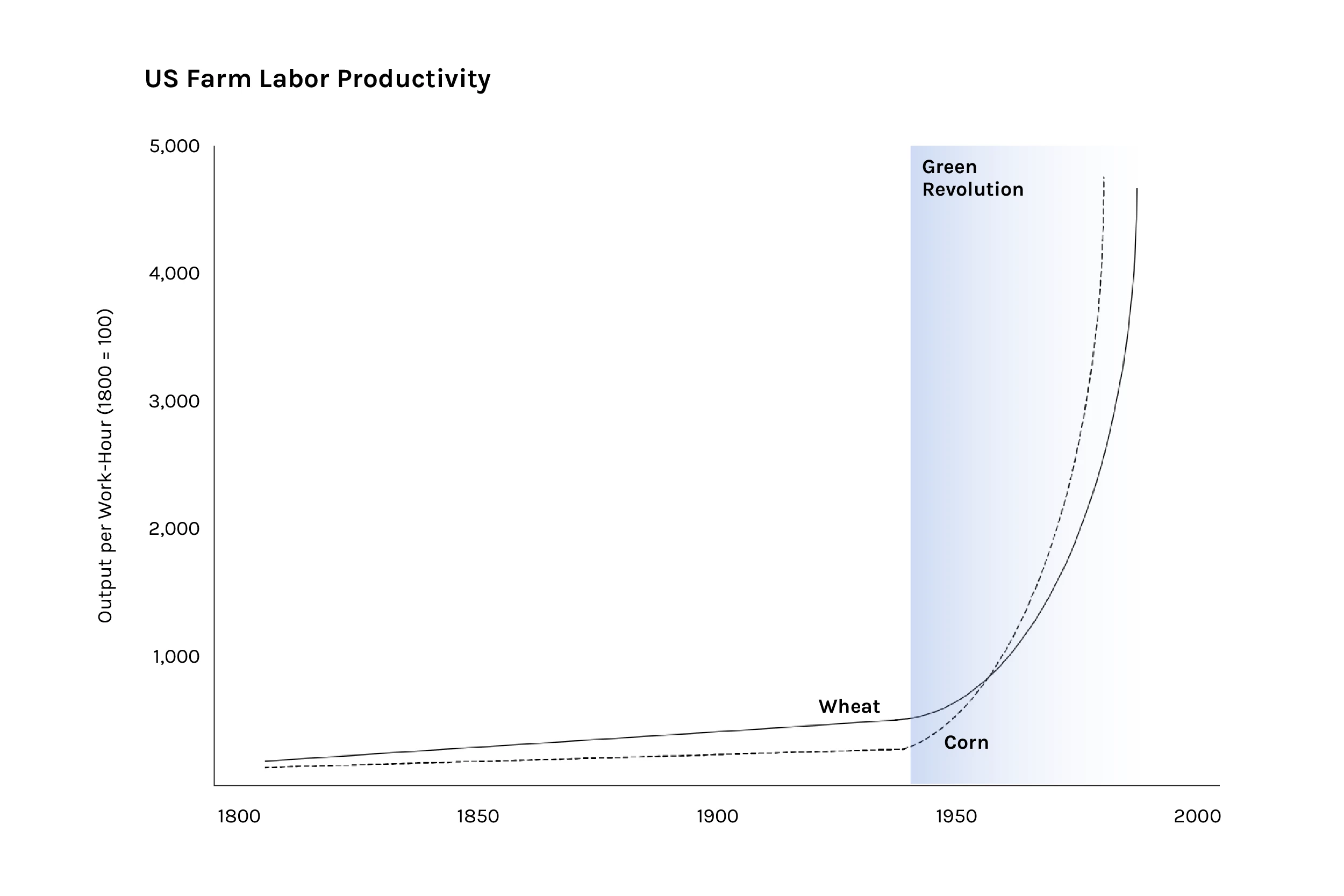
Source: I. Welfeld, Where We Live (Simon and Schuster), CATO
Sustaining the world’s current population would be impossible without the technologies of the Green Revolution. Advances in plant genetics in the mid-20th century enabled the American agronomist (and Nobel Peace Prize laureate) Norman Borlaug to develop high-yield, disease resistant wheat varieties credited with saving more than a billion people from starvation. Chinese agronomist Yuan Longping’s 1970’s development of the world’s first hybrid rice varieties saved an additional billion lives. Without the synthetic nitrogen fertilizers enabled by the chemistry of the Haber-Bosch process, it is estimated that 30-50% of the world’s crops would fail. Productivity increases from mechanized farming equipment have transformed the labor force, enabling modern industrialization; for example, whereas more than 90% of Americans at the founding of the country in 1781 earned their living in agriculture, today only ~1% of US workers are employed in agriculture. Thus, as much as any technological breakthrough, agtech enabled and sustains the modern world.
Agriculture’s Urgent Problems and Emerging Breakthrough Solutions
Unfortunately, the rapid implementation of these advances resulted in severe unintended consequences. Along with increased yields, agricultural industrialization also intensified environmental pollution from chemical inputs, exacerbated soil erosion due to aggressive farming practices, amplified social inequalities by excluding small-scale farmers, and resulted in unsustainable levels of greenhouse gas emissions. All told, modern industrial agriculture contributes 21-37% of total net anthropogenic greenhouse gas emissions. It isn’t news to anyone that our current global warming trajectory, if continued unchecked, will result in catastrophic, existential consequences, highlighting the urgent need for more sustainable agricultural practices.
Modern agriculture is uniquely situated as an industry that relies on stable climate and weather conditions while simultaneously contributing to climate destabilization through greenhouse gas emissions and land-use disturbances. This circumstance sets up a negative feedback loop where agricultural practices aimed at mitigating the short-term effects of global warming on crops result in ever-worsening long-term global warming. For example, inherent inefficiencies in the application of synthetic ammonia-based fertilizers lead to 80% of human-caused nitrous oxide emissions (a greenhouse gas 265 times more potent than CO2), driving global warming. This warming drives an increase in extreme weather events such as drought, flood, and wildfire that threaten agricultural productivity, leading to a need for more ammonia-based fertilizers to offset losses – further increasing warming. Similar feedback loops are set up by the use of synthetic pesticides breeding pesticide-resistant pests, soil erosion and compaction due to mechanized farm practices, increased drought threats due to mismanagement of irrigation, and on and on.
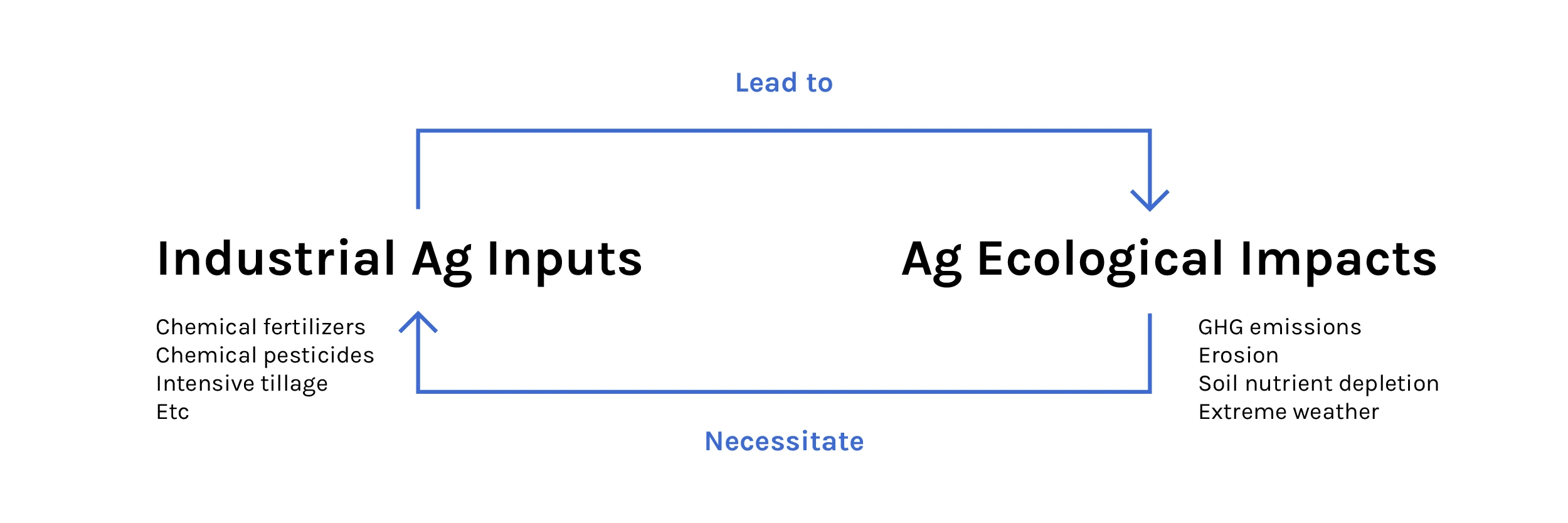
Clearly, we need to find a way to break out of this vicious cycle. A Penn State study estimates that food production needs to increase by as much as 68% by 2050 to feed our growing global population. If agriculture continues on the same trajectory, the only way to get there is through an increased application of the same practices that induce climate change (further threatening yields). Fortunately, agtech innovators have recognized the situation we face, and breakthrough science is being pursued at every level of the value chain.
The combination of pressing humanitarian needs and massive market sizes (agriculture accounts for ~4% of global GDP, representing almost $5 trillion) represent strong incentives for entrepreneurs and innovators in this space, and as a result, there is no shortage of companies introducing potentially world-changing solutions. The Organization for Economic Cooperation and Development (OECD) notes that investments in sustainable agriculture have an outsized positive impact due to their resulting climate change mitigation; OECD estimates that investments in this space of $300-350 billion could result in more than $5 trillion in annual economic gains by 2033. The stage is set for a new revolution in agriculture, one that delivers on the promise of true sustainability for the increased flourishing of humanity through 2050 and beyond.
Getting to the future we all want to see where every human has access to a healthy life of fulfillment and abundance requires solving a lot of pressing problems. We’ll examine the emerging technological solutions to the following critical issues and our investment outlook in those areas:
- Direct ag contributions to the climate crisis
- Soil quality deterioration threatening yields
- Pesticide resistance
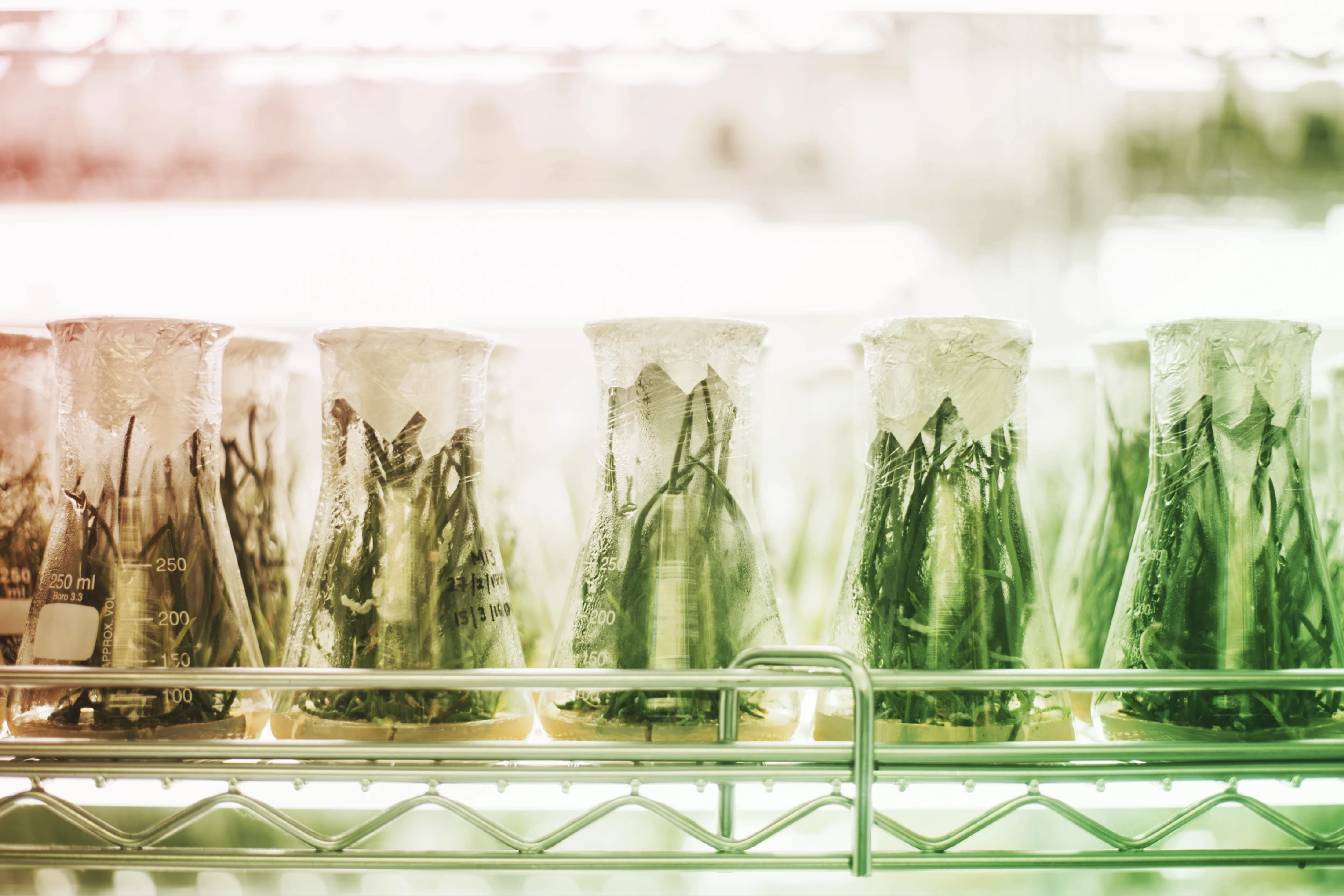
Problem 1: Agriculture’s Contribution to the Climate Crisis
As described above, modern ag practices are significant contributors to the climate crisis. Two technological innovations that are poised to make direct improvements here in the near term are green ammonia and phosphate.
Solution 1: Green Ammonia
Developing an alternative to Haber-Bosch-derived nitrogen fertilizers is an urgent need, because these fertilizers are a potent source of pollution and ecological damage, making farmland less fertile in the long run. The use of such fertilizers negatively impacts soil biodiversity, suppressing nitrogen-fixing bacteria and promoting organisms that deplete organic matter and humus. This results in less fertile soils that require ever more synthetic inputs to support plant growth (see image below). 50-70% of synthetic ammonia added to cropland is lost to the environment in the form of water pollution (resulting in algal blooms that can devastate aquatic populations) and the release of the potent greenhouse gas nitrous oxide. In addition, the production of synthetic fertilizers is unsustainable; nitrogen fertilizer production uses ~2% of global fossil fuels and contributes more than 1% of global greenhouse gas emissions annually.
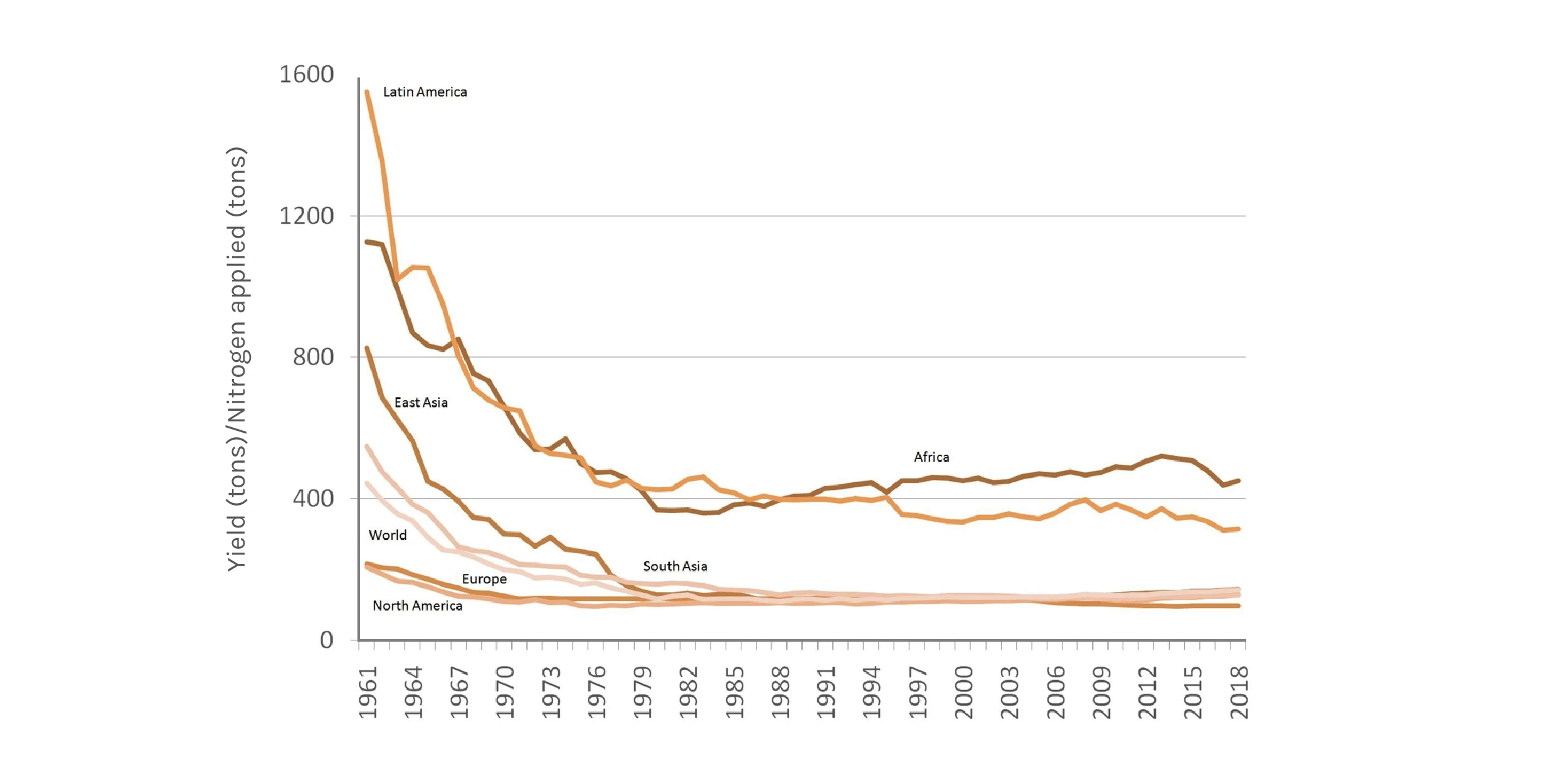
Soil depletion as a result of synthetic fertilizer application has reduced yields per amount of fertilizer applied worldwide since the advent of the green revolution. Source: IATP
Improving upon the carbon-intensive Haber-Bosch process (which has supplied the world’s nitrogen fertilizers for the last century) is no small feat, but promising scientific innovations have brought that goal into the realm of near-term possibility. We recently spoke with Atmonia and Jupiter Ionics, two early-stage companies pioneering solutions in this space. Atmonia's discovery of novel nanoparticle catalysts enables an electrochemical process that creates ammonia directly from air and water without the need for fossil fuels or massive factories, offering a simpler, cheaper, and more versatile alternative to the traditional Haber-Bosch method. Additionally, they've developed a bioreactor-based solution that converts ammonia to nitrate, potentially transforming waste ammonia sources into valuable products, with a successful pilot at a Reykjavík biogas plant achieving up to 100% conversion rates. Jupiter Ionics has a similar electrochemical process based on the MacFarlane Simonov Ammonia Cell, which uses renewable electricity to convert air and water directly into green ammonia, carrying the promise of simpler, more sustainable nitrogen fertilizer production.
Solution 2: Green Phosphate
A similar opportunity exists for phosphate, another key farm input. Unlike nitrogen, which can be directly harvested from the air indefinitely, phosphorus is a thoroughly non-renewable resource; it’s estimated that the world has only 400 years of phosphorus left total, if used at current rates (presumably, humans of the 2400s will still need to eat, so this of course presents a major problem). Seventy percent of global phosphorus rock sources exist in Morocco, where uncertain geopolitics contribute to volatility in phosphorus markets that impact farmers worldwide. Yet using current methods, ~90% of phosphorus applied to fields is lost, mostly from reacting with other soil chemicals to create compounds that plants are unable to metabolize (and phosphorus runoff from soils is also a driver of harmful algal blooms).
The most likely solutions to the dwindling world phosphate supply center around using phosphate more efficiently. Phospholutions, using technology originally invented at Penn State University, has developed a chemistry-driven solution which integrates proprietary metal oxide-based materials into the upstream production process for conventional fertilizers to regulate phosphate release in the soil, ensuring a more consistent availability for plant uptake throughout the entire growing season. This innovation is aimed at making phosphorus more bioavailable and minimizing tie-up, reducing the amount of fertilizer applied to fields and therefore reducing costs for farmers and phosphate waste and runoff. The company’s soil chemistry approach is crop and geography agnostic, presenting a promising platform for a $70B global market.
Investment Outlook: Farm Inputs
The market for chemical fertilizers is approximately ~$200 billion in 2023 globally and generates massive negative externalities, so there’s a great opportunity for doing well through doing good here. Though current practices are thoroughly unsustainable, supplanting “business as usual” here at scale is going to be a difficult prospect because e.g., Haber-Bosch nitrogen fertilizers are proven and generally cheap, benefitting from the economies of scale that can develop in a worldwide industry over many decades. In addition, until the nascent carbon market (described in the next section) matures enough to effectively penalize unsustainable producers (through making sustainable entrants more competitive) companies do not pay a financial cost for downstream climate impacts of their products. Any large-scale product in this space is going to compete with low margin, commoditized products, so fixed Capex costs become very important. If a company needs to scale to enter the market financing risk becomes an important consideration. Further, any solutions must be plug-and-play; the less that wholesalers and farmers need to change about their current operations and equipment to adopt the new technology, the better. Some of the companies discussed in this section benefit from the possibility of shrinking production facilities and enabling more localized production, which is a promising avenue for cutting e.g., shipping and carbon costs.
Problem 2: Soil Degradation Threatening Yields
Soil doesn’t get its due respect. Far from inert matter, soil can be thought of as a living, breathing organism, and the plants it fosters contribute to the soil’s health as much as the soil provides nutrients for the plants. Like other things we traditionally classify as organisms, healthy soil has a well-defined structure, capillaries for regulated water and air flow, and a teeming microbiome for digesting its food (rock and organic matter alike). Without a steady, seasonal influx of organic matter from decaying plants and animals, the soil would effectively die, losing its ability to cycle nutrients and support plant growth (turning into lifeless dirt). In turn, without the preparation of key nutrients provided by the soil microbiome, plants would be unable to grow.
Unfortunately, modern industrial agriculture treats soil in many ways like another outdated piece of farm equipment. Why nurture soils that can recycle key nutrients at a stable, steady rate when those same chemicals can be pumped out of a factory and doused on the field (even traditionally infertile fields) at will? Intensive farming practices, driven by the demand for higher yields, have led to significant soil degradation, which encompasses a range of issues, including salinization, waterlogging, compaction, pesticide contamination, a decline in soil structure quality, acidification/alkalization, and erosion. One of the most concerning aspects is soil erosion, which involves the wearing away of the nutrient-rich topsoil layer by water, wind, or farming activities (with culprits including tillage, monoculture, overgrazing, chemical overuse, and poor irrigation practices). This topsoil is vital for crop growth due to its fertility, and its loss is not naturally reversible– once that soil matter has gone elsewhere, there’s no natural process in place to bring it back.
Furthermore, soil degradation affects the microbial community within the soil, which plays a crucial role in nutrient cycling, pest and disease control, and the chemical transformation properties of the soil. The loss of these microbial communities can further exacerbate the decline in soil health. The continuous application of synthetic fertilizers and pesticides, coupled with monoculture practices, has further reduced soil biodiversity, making the soil more susceptible to diseases and pests (more diverse soil microbiomes are more likely to include member species with specialized functions that can help the collective more effectively navigate challenges). The cumulative effect of these practices threatens the sustainability of agricultural production, reduces the amount of nutrients stored in the foods we eat, and has resulted in a plateauing of yields despite increasing chemical fertilizer, pesticide and herbicide inputs.
Solution 1: Carbon Markets: Subsidizing Regenerative Agriculture Using Farm Data
“Regenerative agriculture” is a term for a set of sustainable agricultural practices aimed in part at restoring soils to their pre-Green Revolution health. Such practices include cover cropping (planting non-harvest crops between harvest crops to protect soil and restore organic matter), crop rotations (alternating crops to improve soil health), and no-till or minimal till farming (reducing soil disturbance to prevent erosion). Restoring soil health can have an outsize positive environmental impact, because the world's soils (particularly the top three meters) comprise the largest land-based carbon reservoirs, housing approximately 3,200 Pg (petagrams) of carbon in the form of soil organic carbon. Ohio State soil scientist Dr. Rattan Lal calculated that if universally applied, regen ag practices could reduce atmospheric CO2 concentrations by 157 parts per million (ppm) by 2100, exceeding the Paris Climate agreement’s goal of reducing current CO2 concentrations by 75 ppm.
Unfortunately, regenerative agriculture practices are typically more costly than current industrial agriculture practices, so economic incentives drive the largest companies towards less sustainable methods. Carbon markets, which are emerging financial mechanisms that put a price on carbon emissions and provide financial rewards for sustainable farming practices, are geared towards shifting this balance. These markets require measurement, reporting, and verification (MRV) of the implementation of sustainable farming practices and their impacts involving (1) collecting farm data (making soil measurements, taking foliar satellite imagery, collecting farmer reports, performing simulations and modeling) and (2) reporting that data to a carbon market verification agency (such as the American Carbon Registry) that issues carbon credits. Farmers can then either convert those carbon credits to tax credits or sell those carbon credits to other companies which they can use to offset those companies’ carbon footprints, qualifying them for tax credits. This can present a substantial incentive for the adoption of sustainable practices; for instance, in October 2020, an Ohio farmer made over $300,000 by earning and selling carbon credits through Locus Ag and Nori's CarbonNOW marketplace.
While awareness of soil carbon markets is high among farmers, participation remains low due to financial constraints, risk aversion, and lack of robust measurement standards. Farmers operate highly risky operations on thin margins, and carbon markets are not well-enough established to offer an easy entry point. The onus is currently placed on the farmer to take on the new project of collecting and processing farm data: yet another task and skillset to add to an often-overflowing work schedule. Collecting that data requires new expenditures for the equipment and labor, and once that data is gathered, farmers face the risk that it won’t meet the poorly defined standards for what types and extent of farm data constitute creditable activities.
There are innovators working to address these issues from two different angles: (1) developing better sensors to gather farm data (e.g., soil biodiversity and carbon content), and (2) streamlining the collection and management and reporting of farm data. One company pursuing the enhanced sensor strategy is Yard Stick PBC which has developed a novel drill-mounted probe for in situ measurement of soil carbon via VisNIR spectroscopy, resulting in greater efficiency, accuracy, and standardization. Yard Stick's value proposition is providing direct-on-site soil carbon measurements with higher data fidelity at significantly lower costs, replacing the slower and more cumbersome traditional lab testing.
Two companies working on the reporting/verification side of the equation are Continuum Ag and DigiFarmz. Continuum Ag is a soil health data intelligence company that provides a SaaS platform for integrating data and informing farmers on how best to implement regen ag practices. The company teams with several market providers including Rabobank and CIBO and provides a tool for navigating emerging carbon markets, particularly with an eye on capitalizing on the Inflation Reduction Act’s upcoming implementation of 45Z tax credits for low carbon intensity biofuels. DigiFarmz takes a different approach less centered around carbon markets and more around leveraging farm data to help farmers make more informed decisions and reap the natural benefits of regenerative farming (namely, increased yields) more readily. The company builds a digital model of a given farm and uses sophisticated AI modeling to provide farmers and agronomists with actionable steps to take to increase crop yield by 10-50% while reducing resource usage. This approach, coupled with day-to-day weather-responsive updates and a robust database of potential farm solutions, simplifies regen ag onboarding and offers farmers meaningful interaction with their data.
Solution 2: Restoring and Enhancing the Soil Microbiome
Biofertilizers are living organisms with the ability to provide essential nutrients to plants through the natural processes of nitrogen fixation, phosphorus solubilization, or other mechanisms that enhance plant growth and soil fertility. Similarly, biostimulants are substances or microorganisms that, when applied to plants or the soil, enhance nutrient efficiency, tolerance to abiotic stress, and crop quality, without being directly involved in providing essential nutrients. Companies developing biofertilizers and biostimulants have enjoyed massive interest and high valuations in recent years. However, recent data has called into question the efficacy of what could be considered “generation 1” biofertilizer solutions which typically apply just one microorganism to e.g. seeds, where it is then expected to grow on the plant’s roots and supply e.g. nitrogen.
There is a growing suspicion that one organism may not be flexible enough to service the countless varieties of soil compositions and climates across the globe, or compete enough to displace established, albeit suboptimal, native microbes. In response, several companies are taking the approach of applying consortia of microorganisms (several microorganism species, often forming mutualistic relationships) simultaneously to deliver target functions. Going beyond the advanced genomics, single organism directed evolution, and synthetic biology techniques that we've seen in the biofertilizer space to date, these companies are commercializing new methods in evolutionary biology and ecology to create more functional and stable whole communities. Newcomers Peko (disclosure: a Prime Movers Lab portfolio company) and Boost Biomes take this more holistic approach with the view that higher efficacy can be unlocked through the additive/emergent properties of diverse communities of microbes, and that the different members of the consortia can fill different niches required by a given soil composition and environment. Over time, more in-field results will shed light on how these differentiated approaches to shifting soil ecology can help to improve economic outcomes for farmers and environmental benefits for all.
A new innovation in the biostimulant space has been advanced by CroBio, a UK-based company that specializes in the use of crop-root-associated bacteria that secrete cellulose, effectively forming a carbon-rich sponge in the soil and driving enhanced water retention and carbon sequestration. This biotechnology uses genetically engineering microbes to produce cellulose triggered by interactions with plant-secreted sugars and is compatible with gram-negative bacteria-associated crops like corn, wheat and soy. Such biostimulant approaches are also compatible with carbon markets, though how to quantify carbon drawdown by such techniques is an open question.
Investment Outlook: Soil Data and Biostimulants
The investment outlook for biostimulants, biofertilizers, and carbon sequestration appears promising, albeit bundled with uncertainties related to the political climate and market acceptance of carbon pricing. As of now, the lack of robust ways to operationalize carbon markets, particularly in the US, might pose significant limitations. Carbon markets' utility to farmers will be limited until there is more certainty around factors like pricing, measurement, and verification.
Biostimulants and biofertilizers are similarly promising and have different risks. There is generally a regulatory process that can range but is typically six to 24 months. States may also have different labeling requirements. Once a product is approved for sale, companies need to compete with incumbent products that have well-understood benefits and pricing. Adoption will likely take a number of seasons. Active biologicals may not perform identically in all conditions, so companies may need to conduct trials to help farmers get comfort that a product will work on their farm. Navigating this regulatory and commercial process is challenging and time consuming and may require several rounds of financing before a company begins generating significant revenue.
Problem 3: Pesticide Resistance
A fundamental problem with using pesticides is the potential for pathogens to evolve resistance to those methods. The escalating issue of such resistance is casting a grim shadow over global agriculture, transforming previously controllable pests into formidable threats. Factors such as indiscriminate chemical use, recurrent treatment with the same active ingredient, and lack of crop rotation have spurred an alarming increase in the resilience of insects, weeds, and fungal pathogens. Between 500 and 1,000 species of pests have evolved resistance to a pesticide. Scientists report that weeds have evolved resistance to 21 of the 31 known herbicide modes of action across 166 herbicides. Since the 1960s, more than a dozen entire classes of fungicides have become defunct due to the evolution of resistance mechanism. This mounting resistance presents the risk of an irrevocable crisis in food supply and biodiversity given the pivotal role these agrochemicals play in contemporary crop protection.
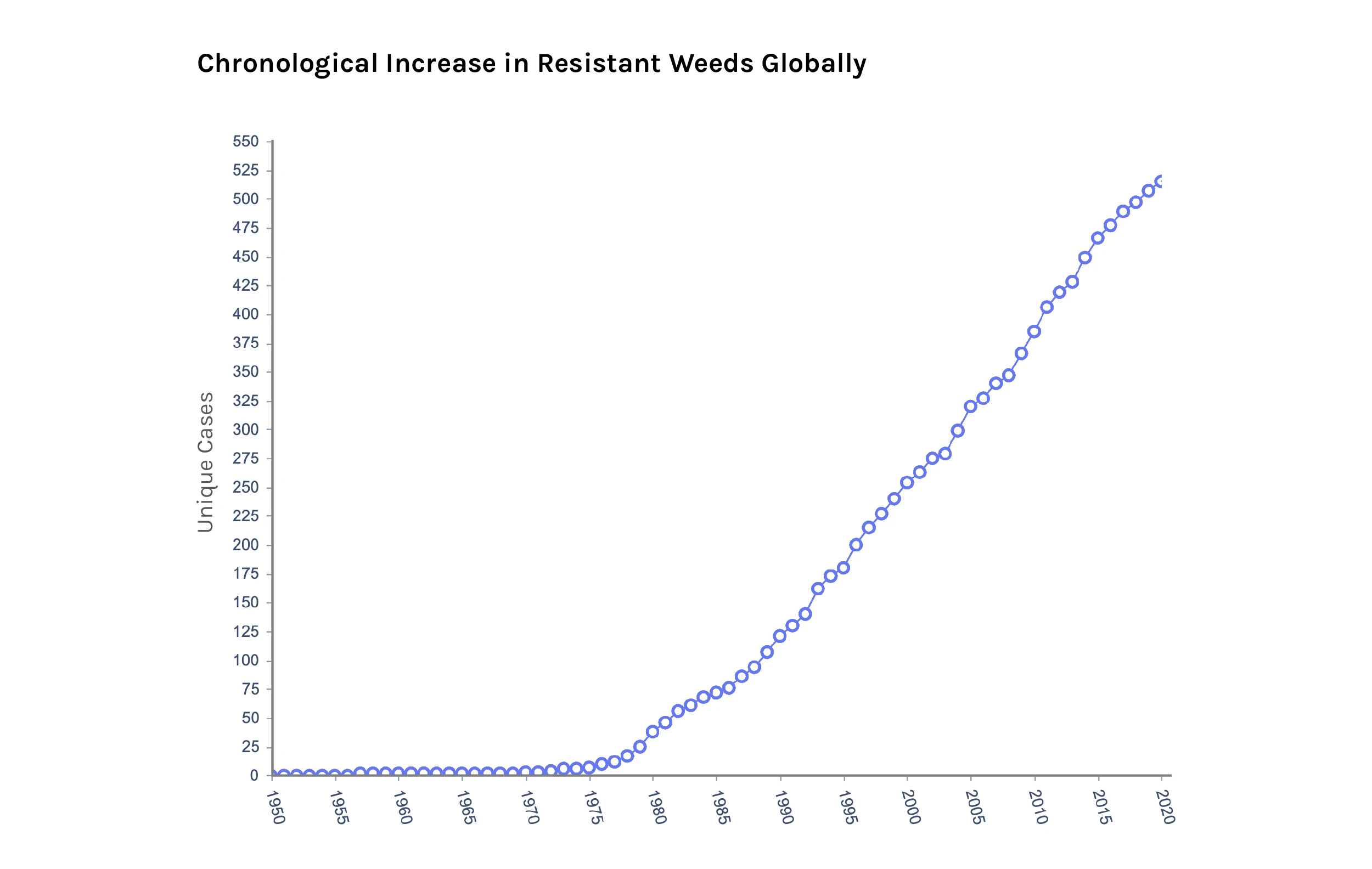
A representative plot of growing pesticide resistance; here, the number of herbicide-resistant weeds is shown over time. Similar plots exist for insecticide, fungicide, and antibiotic resistance. Source: The International Herbicide-Resistant Weed Database
Solution 1: Pesticide Resistance Solution: New Modes of Action
The conventional strategy to circumvent resistance to a given pesticide is to pivot to a chemical for which resistance has yet to evolve. This stop-gap measure has sufficed so far, but often at the cost of entirely lost harvests when a new resistance gene suddenly emerges in a pathogen population (sometimes at a time when there’s no solution in sight). Once these new measures are adopted, the clock begins ticking until evolution outwits us once again.
Breakthrough science in recent years has enabled a more sophisticated understanding of pathogen vulnerabilities, allowing researchers to target modes of action that pathogens are unlikely to be able to evolve around. An extreme example is provided by the startup Carbon Robotics: if an herbicide acts by binding a key membrane transport protein and shutting it off, it’s reasonable to expect that the weed species can develop a workaround by shuffling around that protein’s composition until the herbicide no longer binds, evolving resistance. But if the herbicide is a targeted laser beam – there’s no evolving out of being obliterated by that laser beam.
A subtler method along the same lines involves using breakthrough science to package traditional pesticides in a new way that pests have never encountered. The company Invaio employs a novel synthetic biology platform to produce biologics from microbial-derived particles then envelops them in a protective membrane, thus adding resilience against field degradation, a significant challenge impacting the broader adoption of biologicals in the field. In a holistic approach, they encapsulate active ingredients using lipid nanoparticles that can modulate vascular uptake and soil diffusion, thus enabling potential new applications for existing portfolio activities.
Several companies are mining biology for new organisms that can fight pathogens, based on the thesis that since organisms have evolved through billions of years to solve biological problems, there’s likely already been an undiscovered solution to a given pathogen problem somewhere in nature: we just need to find it and apply it in the right way. One of the companies we spoke with, AgBiome, pursues a rigorous discovery science program to identify new solutions following this paradigm. They intensively study the detailed science of plant microbiomes, then collect and cultivate tens of thousands of naturally existing microbes from various environmental samples. The microbes are tested for their ability to combat a given pathogen, then successful solutions are field tested and commercialized. Another company, MelonFrost, takes a different angle on this approach, leveraging directed evolution of microorganisms informed by a proprietary predictive AI platform to evolve (among other things) pathogen-fighting bacteria.
Investment Outlook: Resistant Pathogens
While there is an abundance of innovation in this space, there are significant hurdles to cross before these solutions will be widely adopted. Regulatory oversight by agencies such as the Environmental Protection Agency (EPA) in the U.S., and the European Food Safety Authority (EFSA) in Europe, necessitate rigorous testing and adherence to stringent guidelines. The process to obtain regulatory approval is laborious, slow and costly. As with biofertilizers and biostimulants, this slow regulatory and commercial adoption process is a challenge for venture funds with a 10-year investment horizon.

Conclusion
Despite the enormous challenges that loom large— climate change, the necessity to scale food production in line with population growth, and the need to limit agricultural contributions to environmental degradation— continued innovation in the agtech sector provides a pathway forward. With advancements in technology and the implementation of sustainable practices, we can revitalize a system currently in a precarious state and re-orient it towards ecological resilience and agricultural abundance.
In reviewing the potential pathways for investment, opportunities are visible across the agtech industry, though each with unique considerations. In general, the work of farmers is hard enough as it is, so any given solution must make their lives easier in the short term- whether by reliably increasing yields, streamlining workflows, or predictably driving profits through carbon credits or ecosystem services. More specifically, the market for chemical fertilizers, while poised for improvement and more sustainable practices, has firmly established incumbents and operational infrastructures. Overturning this status quo will require significant capital, viable plug-and-play solutions, and effective strategies for aligning economies of scale with sustainable product lines – all a tall order, but achievable. Innovations in soil data and biostimulants are nascent and promising, yet heavily contingent on the political and regulatory landscape, especially in the context of operationalizing carbon markets. The growth of this sector may be expedited by innovative companies and early adopters leveraging data-driven insight to motivate legislative changes, thus improving prospects for technologies like carbon sequestration. Similarly, developments targeting the resistance of pathogens are hampered by lengthy regulatory approval processes and a risk-averse adoption atmosphere, making it crucial for novel solutions to demonstrate clear and tangible benefits to farmers' yields or cost savings.
With the world shifting gears towards sustainability, partly due to growing climate awareness and partly due to evolving economic incentives, we're seeing a real uptick in the backing of game-changing agtech. This shift isn't just good for the earth, it hints at attractive investment returns and moves us step by step towards a shared dream: a vigorous, green, and resilient agriculture industry.
Landscape
Sustainable Ag Chemicals
AtmoniaJupiter Ionics
Khepra
Nitrofix
Nitricity
Phospholutions
True Algae
Regenerative Ag
Continuum AgDigiFarmz
Yard Stick PBC
Biofertilizers/Biostimulants
PekoAgrobiomics
CroBio
Boost Biomes
MelonFrost
Napigen
Terra Bioforge
Biopesticides
ActiveCrossAgBiome
Auxergen
Invaio
Lytos Tech
MicroMGx
RNAissance Ag
Wildfires/Forestry
Mast ReforestFarm Automation/Robotics/Precision Ag
Barn OwlCarbon Robotics
Kray
Nexat
